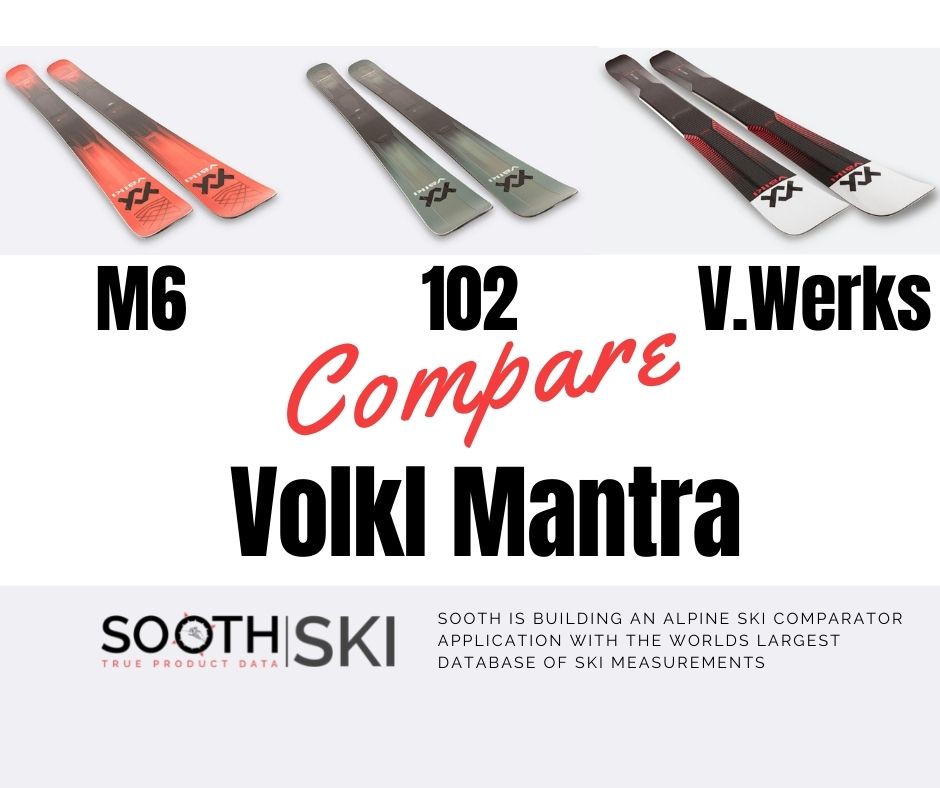The Volkl Mantra has quite a standing out there. A quick scan through the main ski reviews online and anyone would conclude that the Mantra is an "iconic", "mythical", "legendary", award winning freeride ski. In this post, I will go over the Volkl Mantra evolution in time.
At the time of writing this post, we have 25 Mantra available on our Ski Comparator Application. It is also worth mentioning that our measures include older editions, so if you skied any older edition from as far as 2012, you can compare to the current versions.
Mantra evolution in time
The oldest edition we have in our database is from 2011/2012 season. But the model was actually introduced in 2004. When it came out, the "new thing" was the width combined with a parabolic shape, because if you remember those days, fat skis were uncommon and useless on a firm base. But the Mantra showed you can combine carving and powder abilities to a single ski.
I personally still own a pair of 2013/2014. I remember having searched for a while in used ski adds, because I specifically enjoyed the versatility of this edition and I had just exploded an edge in a ski trip in Austria. To this day, it is the ski I travelled the most with. It could handle any unexpected conditions, from an 8ft memorable snowfall in Wolf Creek Colorado to the driest season in Gudauri Georgia where edge grip was vital to have any kind of fun.
The Big Periods Of The Mantra Evolution Over Time
We could breakdown the eras of evolution of the Mantra into a four part story:
- The original Mantra with a regular camber design (2004/2005),
- The reverse and flat camber period (2015/2016)
- The return to camber period with the M5, for fifth generation (2018/2019),
- Finally, the period where Volkl introduced alternatives (since 2019/2020).
If you want to read about some of the history of the Mantra, I recommend the following article:
https://www.californiaskicompany.com/2020/06/09/volkl-mantra-m5/
Geometry evolution
As you can see in the images below, the Volk Mantra has evolved a lot from one period to another. The first version came with a traditional camber and nearly no rockers. Then came the reverse camber that you can easily see in the 2016 & 2017 measures in the images below. Finally the return of a camber in 2018 but with rockers. This camber increased further from 2018 to 2020 and beyond.
Note that we did not have the exact same lengths in the 5 skis presented, but they were offered in the same lengths.

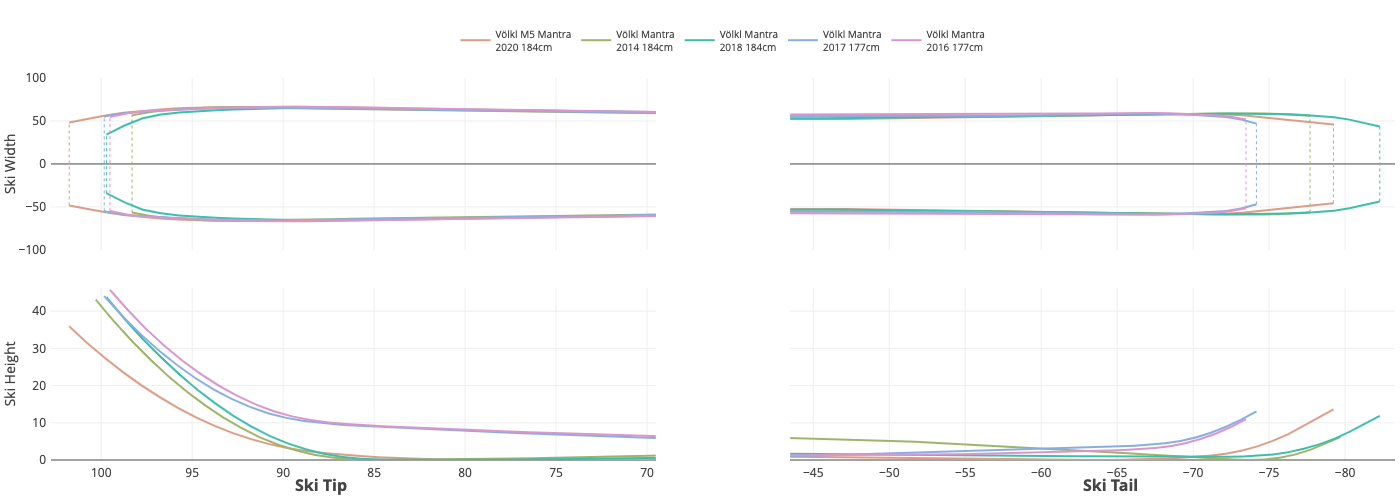
Bending & Torsional Stiffness Evolution Over Time
The bending and torsional stiffness have also dramatically evolved in time. The first chart below compares the average bending and torsional stiffness values. Those values are staggering when you consider the stiffest is more than double the value of the softest! The 2016/2017 model is by far the stiffest in both bending and torsional values. Actually, it is the highest value we have measured for torsional stiffness so far. Torsional stiffness is related to edge grip and playfulness. A stiff ski will have better edge grip and will be less playful. At the other ends, the 2015/2016 is the softest in bending and the 2017/2018 is the softest in torsional stiffness. This clearly demonstrated to what extent the construction of a ski can change over time, even if it carries the same name!
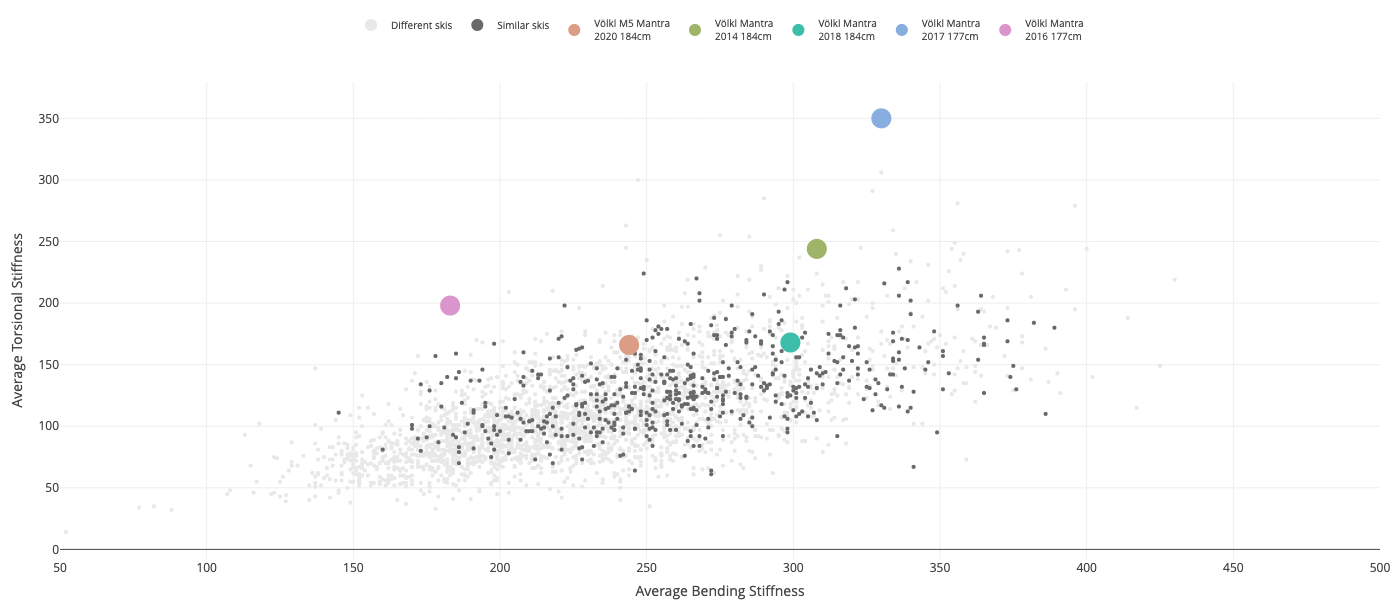
reading the torsional vs bending stiffness charts
This chart requires very little time to understand and make sens of, but a few basic elements need to be explained:
- Never look at this as an absolute rating. You must look at the dots as relative to one another (one higher than another, one more left or right than another one...).
- The values are average. To get the entire story, you need to look at the profile of distribution. Essentially, in this chart you don't see the detail of a specific area, such as tip/tail for example. A ski behavior on the snow may vary considerably based on a specific area.
- Many skis considered similar may have differences of more than 20% on one of the scales. Consider that differences of less than 10% are very difficult to notice while skiing. So don't dig too far in the details, there are plenty of variations of more than 20% to search and compare!
The horizontal axis is for bending stiffness. Towards the left means the ski will be softer (bending). We tend to accept that softer skis have a lower speed comfort zone. But since we all have different comfort zones, ideally you spot skis you know and compare relative to those.
The vertical axis is for torsional stiffness. Towards the bottom means the ski will be softer (torsional). Torsional stiffness affects directly the playfulness and the edge grip. Lower torsional stiffness will be more playful and less edge grip.
The horizontal axis is for bending stiffness. Towards the right means the ski will be stiffer (bending). We tend to accept that stiffer skis have a higher speed comfort zone. But since we all have different comfort zones, ideally you spot skis you know and compare relative to those.
The vertical axis is for torsional stiffness. Towards the top means the ski will be stiffer (torsional). Torsional stiffness affects directly the playfulness and the edge grip. Higher torsional stiffness will provide more edge grip and will feel less playful.
The chart below shows the bending and torsional stiffness distribution. Here again, you can witness the important changes that were integrated over time on the Volkl Mantra.

Comparison Table
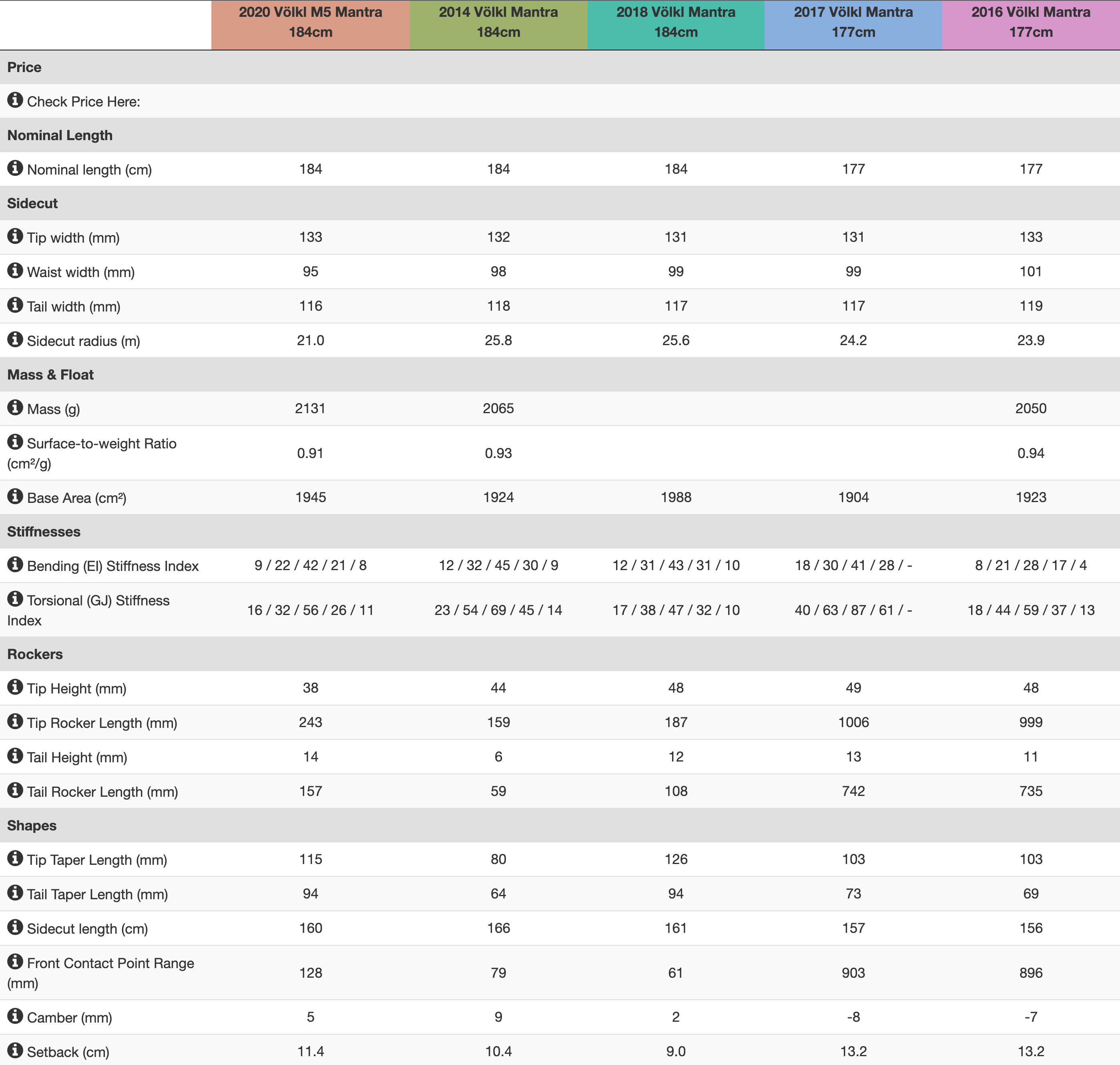
Which Mantra Have You Liked The Most?
As mentioned in the introduction, I have once searched used ski adds to find an older model of the Mantra, namely the ones produced from 2011 to 2014. This doesn't mean that other version were not good. The variations Volkl has introduced over the years were on the profile (camber and rockers) and bending & torsional stiffness. Those parameters are very personal to each skier. You cannot expect to simply rely on the comment of one person to declare that the skis is good or bad. Everyone's tastes are different. I often repeat: "there are no good or bad skis out there, but there are skis more appropriate for certain skiers".
In an ideal world of ski tests and buyer's guide, the ratings would adapt to a personal scale that each reader would define and own. As we saw, each periods of the Mantra were very different on some basic aspects. For each period, there has always been a set of fans for these skis, but not necessarly the same people over time. So I'm curious to know, what was your favorite period of the Volkl Mantra and what did you mostly enjoy about it?
Subscribe
Don't miss the next article. Follow our development. Get exclusive insights. Thank you for supporting us.
By subscribing, you accept our privacy policy that can be consulted at anytime here.
The Volkl Mantra Today: M6, 102 & V.Werks
Today, the M6 is very similar to the M5. But Volkl has also introduced the 102 and the V.Werks. We know the 102 is larger and the V.Werks is lighter. Anyone can determine this. In terms of profile, you can place the M5, M6, 102 and V.Werks against each and you will notice they look very similar on the camber, rockers, tip and tail. So are there any significant differences? Yes there are and I will cover those in the Part 2 of this article. Stay tuned to read the rest, or go explore on our Ski Comparator Application and find the answers yourself. There are significant differences in some aspects of stiffness, which you can see with our application. That's why we published this comparator application!
You can find out prices for those skis following those links.
Model | Ski Essentials | Utah Skis | Dreamruns | Skis.com |
|---|---|---|---|---|
Volkl Mantra M5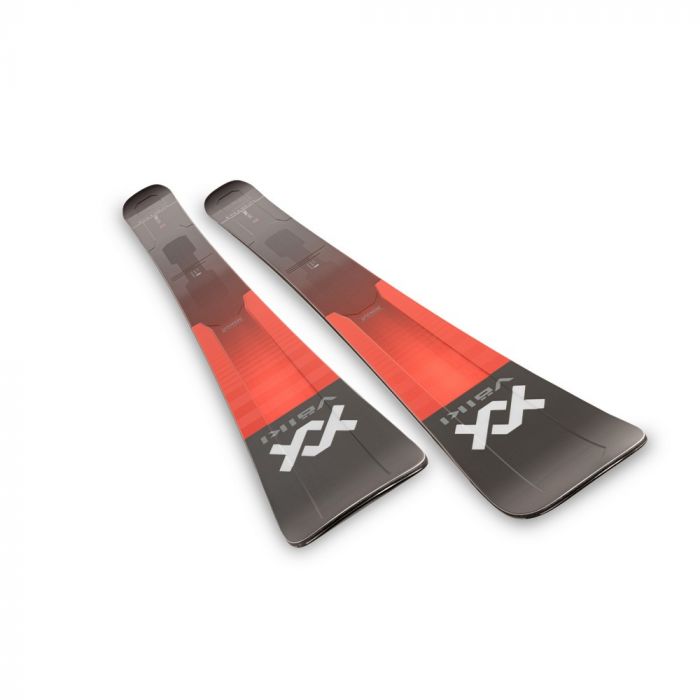 | Check price (20/21) | Check Price (20/21) | Cell | Check Price (20/21) |
Volkl Mantra M6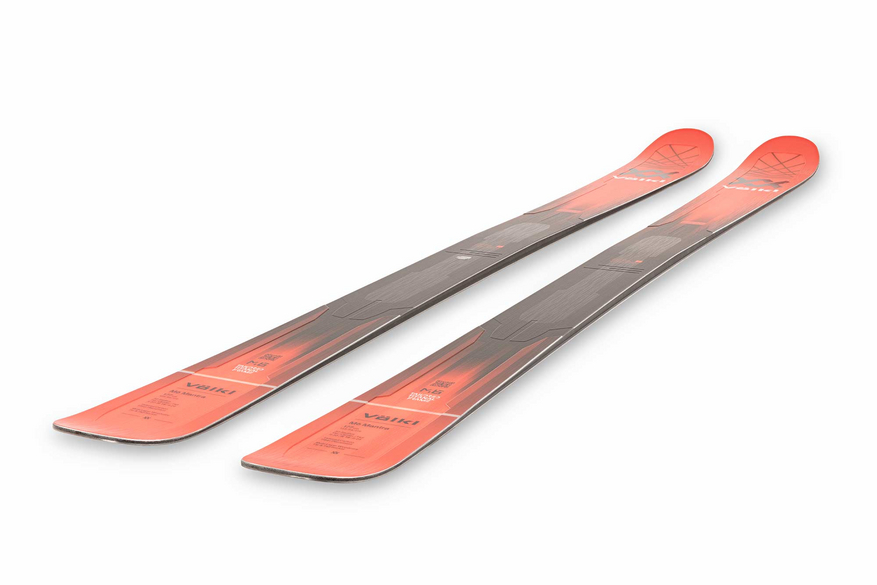 | Check Price (21/22) | Cell | Check Price (21/22) | Cell |
Volkl Mantra 102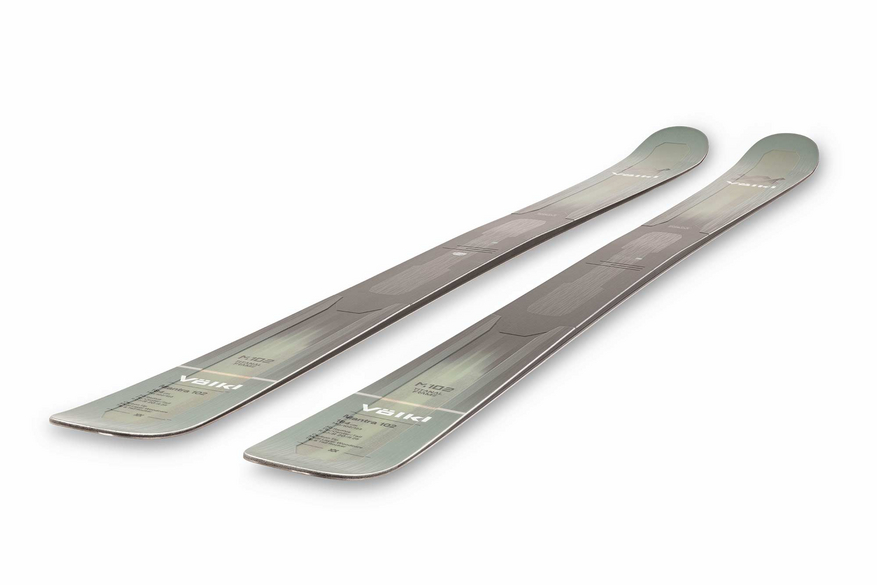 | Check Price (21/22) | Check Price (20/21) | Cell | Check Price (20/21) |
Volkl Mantra V.Werks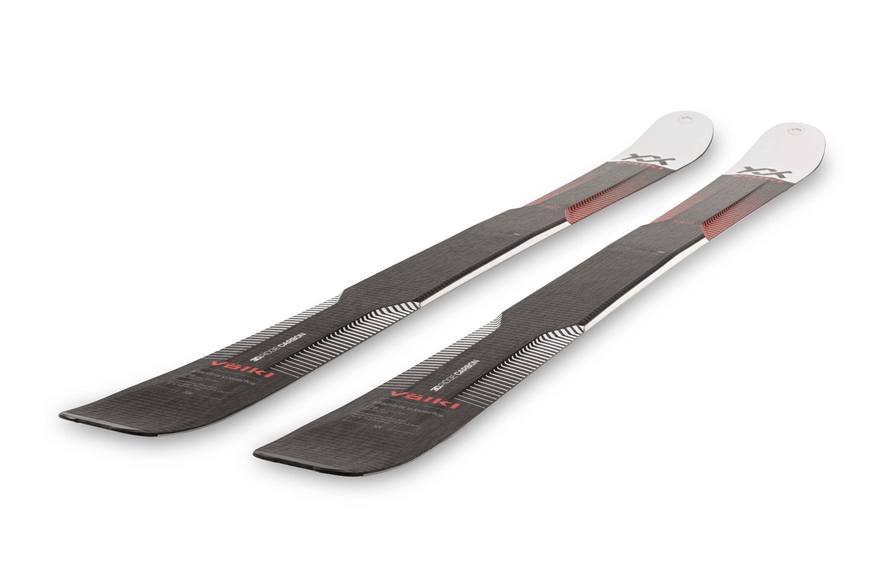 | Check Price (21/22) | Cell | Cell | Cell |
affiliation & relations with shops
To help us further develop our measuring technology and our Ski Comparator Application, we have integrated some affiliate links and we also refer to shops who have welcomed us to measure the skis they sell. We may receive indirect compensation from shops if you use an affiliate link either from our website or our Ski Comparator Application. We may also refer skiers to shops that support our project by giving us access to measure skis. We thank you for helping us maintain our Ski Comparator Application 100% free.
You are also welcome to contribute with donations. Thank you for supporting us.

